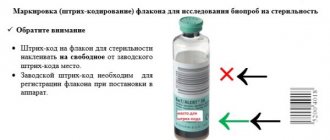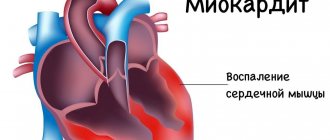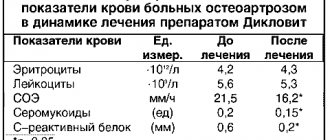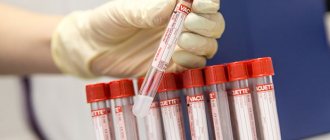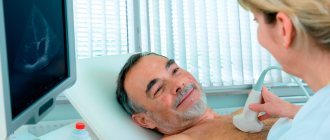Published: 06/20/2012 Updated: 05/20/2021
Diagnosis of infectious diseases is one of the most difficult problems in clinical medicine. Laboratory research methods play a leading role in a number of nosological forms, and in a number of clinical situations they play a decisive role not only in diagnosis, but also in determining the final outcome of the disease.
Diagnosis of infectious diseases almost always involves the use of a complex of laboratory methods.
The network of independent laboratories "CityLab" uses 3 groups of special laboratory research methods in its work to diagnose infectious diseases:
- bacteriological;
- serological;
- polymerase chain reaction (PCR) method for detecting DNA or RNA of the causative agent of an infectious disease in the material being studied.
In some patients, to diagnose the etiology of the infectious-inflammatory process, it is enough to conduct a bacteriological study; in other clinical situations, data from serological studies are decisive; thirdly, only the PCR method can provide useful information. However, most often in clinical practice, a clinician needs to use data from various laboratory research methods.
Bacteriological research methods
Bacteriological studies are most often carried out when purulent-inflammatory diseases are suspected (accounting for 40-60% of the structure of surgical diseases) for the purpose of diagnosing them, studying the etiological structure, and determining the sensitivity of pathogens to antibacterial drugs. The results of bacteriological analyzes contribute to the selection of the most effective drug for antibacterial therapy and timely implementation of measures to prevent nosocomial infections.
The causative agents of purulent-inflammatory diseases are truly pathogenic bacteria, but most often opportunistic microorganisms that are part of the natural microflora of humans or enter the body from the outside. Truly pathogenic bacteria in most cases contribute to the development of an infectious disease in any healthy person. Opportunistic microorganisms cause diseases mainly in people with impaired immunity.
Bacteriological studies for diseases caused by opportunistic microorganisms are aimed at isolating all microorganisms found in pathological material, which significantly distinguishes them from similar studies for diseases caused by truly pathogenic microorganisms, when a search for a specific pathogen is carried out.
To obtain adequate results of bacteriological research in purulent-inflammatory diseases, it is especially important to comply with a number of requirements when taking biomaterial for analysis, transporting it to the laboratory, conducting research and evaluating its results.
To identify the type of causative agent of purulent-inflammatory diseases and determine sensitivity to antibacterial drugs, bacteriological laboratories use a set of methods. These include:
- microscopic examination of a smear (bacterioscopy) from the delivered biomaterial;
- growing a culture of microorganisms (cultivation);
- identification of bacteria;
- determination of sensitivity to antimicrobial drugs and evaluation of study results.
The biomaterial delivered to the bacteriological laboratory is initially subjected to microscopic examination.
Microscopic examination of a smear (bacterioscopy) , stained with Gram or other dyes, is carried out when examining sputum, pus discharged from wounds, mucous membranes (smear from the cervical canal, pharynx, nose, eye). The results of microscopy make it possible to roughly judge the nature of the microflora, its quantitative content and the ratio of various types of microorganisms in the biological material, and also provide preliminary information about the detection of an etiologically significant infectious agent in this biomaterial, which allows the doctor to immediately begin treatment (empirical). Sometimes microscopy makes it possible to identify microorganisms that do not grow well on nutrient media. Based on microscopy data, nutrient media are selected for growing microbes found in the smear.
Cultivation of microorganisms. Inoculation of the studied biomaterial on nutrient media is carried out in order to isolate pure cultures of microorganisms, establish their type and determine sensitivity to antibacterial drugs. For these purposes, various nutrient media are used to isolate the largest number of types of microorganisms. Optimal are nutrient media containing animal or human blood, as well as sugar broth, media for anaerobes. At the same time, inoculation is carried out on differential diagnostic and selective (intended for a specific type of microorganisms) media. Sowing is carried out on sterile Petri dishes, into which a nutrient medium for the growth of microorganisms is first poured.
Microscopy of Gram-stained smears
1 - streptococci; 2 - staphylococci; 3 — Friedland diplobacteria; 4 - pneumococci
Petri dishes with crops are incubated in a thermostat at certain temperature, and for a number of microorganisms, gas (for example, conditions with low oxygen content are created for growing anaerobes) conditions for 18-24 hours. The Petri dishes are then scanned. The quantitative contamination of the delivered biomaterial with microflora is determined by the number of colony-forming units (CFU) in 1 ml or 1 mg of the test sample. When viewing Petri dishes, some features of changes in the color of the medium and its brightening during the growth of the culture are revealed. Many groups of bacteria form characteristic colony shapes and secrete pigments that color the colonies or the environment around them. Smears are made from each colony, stained with Gram and microscopically examined. The homogeneity of bacteria, shape and size, the presence of spores or other inclusions, capsules, location of bacteria, and relation to Gram staining are assessed. All this information serves as a critical component for selecting media and subsequently obtaining a pure culture of each microorganism.
Colonies are screened onto solid, liquid, and semi-liquid nutrient media that are optimal for cultivating a particular type of bacteria.
Isolated pure cultures of microorganisms are subjected to further study in diagnostic tests based on morphological, enzymatic, biological properties and antigenic characteristics characterizing bacteria of the corresponding species or variant.
Identification is a set of bacteriological methods for studying bacteria that allows one to determine the type of microorganism. In the Citylab Laboratory, identification of most types of bacteria and fungi is carried out on an automatic bacteriological analyzer using foreign-made diagnostic panels: on a research result form in the form of the name of the microorganism or its genus, for example, Streptococcus pneumoniae (pneumococcus) or Eschrichia coli (Escherichia coli).
Determination of sensitivity to antibacterial drugs. Sensitivity to antimicrobial drugs is studied in isolated pure cultures of microorganisms that have etiological significance for a given disease. Therefore, in a referral for bacteriological tests, it is necessary to indicate the diagnosis of the patient’s disease. Determining the sensitivity of bacteria to a spectrum of antibiotics helps the attending physician choose the right drug to treat the patient.
In the Citylab Laboratory, the sensitivity of an isolated pure culture of most species of bacteria and fungi is determined on an automatic bacteriological analyzer using foreign-made diagnostic panels to a wide range of modern antibacterial drugs (from 6 to 32 drugs, depending on the isolated microorganism) with the determination of the minimum inhibitory concentration (MIC). On the form for determining sensitivity to antibacterial drugs, the designation R indicates resistance, I - moderate sensitivity, S - sensitivity of the microorganism to this drug.
Evaluation of research results. The fact that opportunistic microorganisms belong to the natural microflora of the human body creates a number of difficulties in assessing their etiological role in the development of purulent-inflammatory diseases. Opportunistic microorganisms can represent the normal microflora of the liquids and tissues being examined or contaminate them from the environment. Therefore, to correctly assess the results of bacteriological studies, it is necessary to know the composition of the natural microflora of the sample being studied. In cases where the biomaterial under study is normally sterile, such as cerebrospinal fluid, exudates, all microorganisms isolated from it can be considered pathogens. In cases where the material under study has its own microflora, such as vaginal discharge, feces, sputum, it is necessary to take into account changes in its qualitative and quantitative composition, the appearance of unusual types of bacteria, and the quantitative contamination of the biomaterial. For example, during a bacteriological examination of urine, the degree of bacteriuria (the number of bacteria in 1 ml of urine) equal to or higher than 105 indicates a urinary tract infection. A lower degree of bacteriuria occurs in healthy people and is a consequence of urine contamination by the natural microflora of the urinary tract.
The increase in the number and repetition of isolation of bacteria of the same species from a patient during the course of the disease also helps to establish the etiological role of opportunistic microflora.
The clinician should know that a positive result of a bacteriological test in relation to biological material obtained from a normally sterile lesion (blood, pleural fluid, cerebrospinal fluid, organ or tissue puncture) is always an alarming result that requires immediate action to provide medical care.
Should I get tested for coronavirus?
Every second Russian asked himself this question. So, even children know what coronavirus is, but not everyone knows in what cases it is necessary to take a test for the virus, and when it is absolutely not advisable. Six groups of the population are recommended to be tested for coronavirus infection:
- people with obvious symptoms of ARVI and chronic diseases;
- elderly people over 60 years of age with signs of respiratory infections;
- citizens who have been abroad in the last two weeks;
- people who have been in contact with those who have tested positive for the virus and those who have been abroad in the last two weeks;
- patients with pneumonia.
A referral for examination is issued by the attending physician. If you do not have any signs of infection, you have not been abroad and have not had contact with people who are sick or have been abroad, then undergoing an examination will not be advisable for you. If you fall into one of the six groups listed above, be sure to consult a doctor. He will tell you what to do next and give you a referral for a test.
Serological research methods
All serological reactions are based on the interaction of antigen and antibody. Serological reactions are used in two directions.
1. Detection of antibodies in the blood serum of the subject for diagnostic purposes. In this case, of the two components of the reaction (antibody, antigen), the unknown is the blood serum, since the reaction is carried out with known antigens. A positive reaction result indicates the presence in the blood of antibodies homologous to the antigen used; a negative result indicates their absence. Reliable results are obtained by studying “paired” patient blood sera, taken at the beginning of the disease (3-7 days) and after 10-12 days. In this case, it is possible to observe the dynamics of the growth of antibodies. For viral infections, only a fourfold or greater increase in antibody titer in the second serum has diagnostic value.
With the introduction of the enzyme-linked immunosorbent assay (ELISA) method into laboratory practice, it became possible to determine antibodies belonging to various classes of immunoglobulins (IgM and IgG) in the blood of patients, which significantly increased the information content of serological diagnostic methods. During the primary immune response, when the human immune system interacts with an infectious agent for the first time, predominantly antibodies belonging to class M immunoglobulins are synthesized. Only later, 8-12 days after the antigen enters the body, class G immunoglobulin antibodies begin to accumulate in the blood. During the immune response to infectious agents, class A antibodies (IgA) are also produced, which play an important role in protecting the skin and mucous membranes from infectious agents.
2. Establishing the genus and species of a microbe or virus. In this case, the unknown component of the reaction is the antigen. Such a study requires a reaction with known immune sera.
Serological tests do not have 100% sensitivity and specificity for the diagnosis of infectious diseases, and may give cross-reactions with antibodies directed to antigens of other pathogens. In this regard, it is necessary to evaluate the results of serological studies with great caution and taking into account the clinical picture of the disease. This is what explains the use of multiple tests to diagnose one infection, as well as the use of the Western blot method to confirm the results of screening methods.
In recent years, progress in the field of serological research is associated with the development of test systems for determining the avidity of specific antibodies to pathogens of various infectious diseases.
Avidity is a characteristic of the strength of the connection of specific antibodies with the corresponding antigens. During the body's immune response to the penetration of an infectious agent, a stimulated clone of lymphocytes begins to produce first specific IgM antibodies, and somewhat later specific IgG antibodies. IgG antibodies initially have low avidity, that is, they bind the antigen quite weakly.
Then the development of the immune process gradually (this can be weeks or months) moves towards the synthesis by lymphocytes of highly specific (high-avidity) IgG antibodies that bind more firmly to the corresponding antigens. Based on these patterns of the body’s immune response, test systems have now been developed to determine the avidity of specific IgG antibodies in various infectious diseases.
The high avidity of specific IgG antibodies makes it possible to exclude recent primary infection and thereby, using serological methods, establish the period of infection of the patient. In clinical practice, the most widespread determination of the avidity of IgG class antibodies for toxoplasmosis and cytomegalovirus infection, which provides additional information useful in diagnostic and prognostic terms when these infections are suspected, especially during pregnancy or planning pregnancy.
IgM antibodies
Their concentration increases soon after the disease. IgM antibodies are detected as early as 5 days after onset and reach a peak between one and four weeks, then decline to diagnostically insignificant levels over several months, even without treatment. However, for a complete diagnosis, determining only class M antibodies is not enough: the absence of this class of antibodies does not indicate the absence of the disease. There is no acute form of the disease, but it may be chronic.
IgM antibodies are of great importance in the diagnosis of hepatitis A and childhood infections (rubella, whooping cough, chickenpox), easily transmitted by airborne droplets, since it is important to identify the disease as early as possible and isolate the sick person.
Polymerase chain reaction method
Polymerase chain reaction (PCR), which is one of the DNA diagnostic methods, allows you to increase the number of copies of the detected genome region (DNA) of bacteria or viruses millions of times using the DNA polymerase enzyme. The tested genome-specific nucleic acid segment is multiplied (amplified) many times, which makes it possible to identify it.
First, the DNA molecule of bacteria or viruses is divided into 2 chains by heating, then in the presence of synthesized DNA primers (the nucleotide sequence is specific to the genome being determined), they are bound to complementary sections of DNA, the second nucleic acid chain is synthesized after each primer in the presence of thermostable DNA polymerase . This results in two DNA molecules. The process is repeated many times. For diagnosis, one DNA molecule, that is, one bacterium or viral particle, is sufficient.
The introduction of an additional stage into the reaction—DNA synthesis on an RNA molecule using the enzyme reverse transcriptase—made it possible to test RNA viruses, for example, hepatitis C virus. PCR is a three-step process that is repeated cyclically: denaturation, primer annealing, DNA synthesis (polymerization). The synthesized amount of DNA is identified by enzyme immunoassay or electrophoresis.
Various biological materials can be used in PCR - serum or blood plasma, scraping from the urethra, biopsy material, pleural or cerebrospinal fluid, etc. First of all, CPR is used for the diagnosis of infectious diseases, such as viral hepatitis B, C, D, cytomegalovirus infection, sexually transmitted infectious diseases (gonorrhea, chlamydial, mycoplasma, ureaplasma infections), tuberculosis, HIV infection, etc.
The advantages of PCR in diagnosing infectious diseases over other research methods are as follows:
- the infectious agent can be detected in any biological environment of the body, including material obtained from a biopsy;
- it is possible to diagnose infectious diseases at the earliest stages of the disease;
- the ability to quantify research results (how many viruses or bacteria are contained in the material being studied);
- high sensitivity of the method; for example, the sensitivity of PCR for detecting hepatitis B virus DNA in blood is 0.001 pg/ml (approximately 4.0.102 copies/ml), while the DNA hybridization method using branched probes is 2.1 pg/ml (approximately 7.0.105 copies/ml).
Author:
Baktyshev Alexey Ilyich, General Practitioner (family doctor), Ultrasound Doctor, Chief Physician
